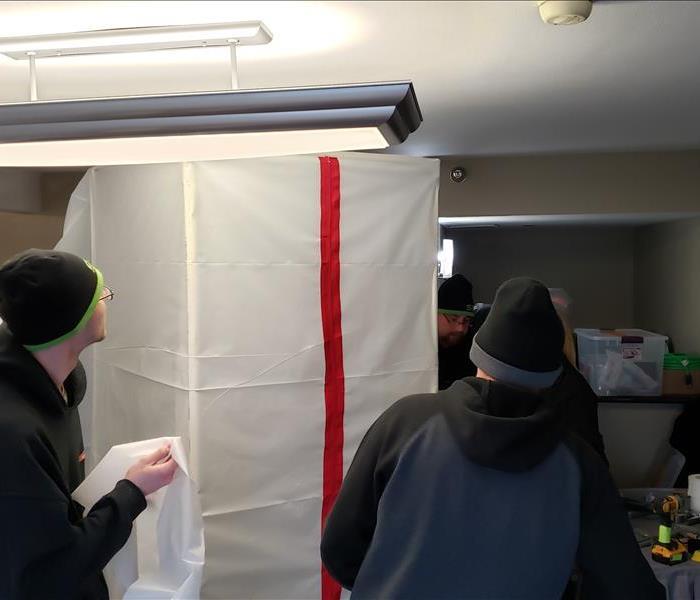Mold Remediation Training - Containment
12/26/2019 (Permalink)
At the beginning of December, we sent two of our employees to a training opportunity held by the IIRCC.
Devon and Jeremy (production technicians) participated at a 4-day training of Mold Remediation alongside other Iowa’s SERVPRO employees. Scott, the owner of our Franchise, requested that they take thorough notes to report back to the office. We are always open to new techniques or best practices in our field. Luckily, these guys are team players and did exactly that. They had two experienced Instructors, Luis, a highly successful field expert from Australia and Rachel who has basically written the book on Mold Remediation. One of the training practices that we were very intrigued about is called “pressure fit containment” for mold remediation.
Mold releases spores when messed with so we must contain the affected room or area. We do this already by using 8-millimeter plastic and tape. A pressure fit containment requires more material. The pros of building a pressure fit containment are that it can be less invasive than using tape on painted walls. A tape can remove paint. The con is that the cost is more expensive and there’s the possibility that insurance may not cover it.
Pressure Fit Containment
A pressure fit containment is a frame constructed to fit in a doorway or entry. The frame is held by the pressure of 2 x 4” wood boards. Then the plastic is stapled tightly on the board. To get inside the containment, a zipper is attached straight down from the top frame to the bottom. The zipper has an adhesive in the back of it so it’s easy to attach right onto the plastic. After its attached, the zipper is unzipped and the plastic is cut straight down from in between the open zipper. The trainees had hands-on training on how to do exactly this in a demonstration room.
Aside from the pressure fit containment, they also built an exit chamber to be attached. The materials that are used are PVC pipes (nonporous material) and plastic that is glued on and wrapped around most sides except for the area that will attach to the main containment by plastic and tape. After they built it, the trainees attached it to the main containment. This area is used to enter after exiting the affected area so that the person can be HEPA (High-Efficiency Particulate Air) vacuumed. When someone exits the chamber, all the spores or unclean air from their clothes, body and the chamber itself would have been removed. I have to mention that the plastic that they and we use is fire-resisting so in the case of a fire, the plastic will not engulf into flames spreading the fire but instead it would melt. Fire safety is quite important to us.
Back in the office, we were able to see exactly what went on because Devon brought back great pictures that showcases the training. Knowledge is power and we care about what we do. Our vision is to be the best in the world for restoration so training our team will help us achieve that! If you want to see the pictures Devon brought back, CLICK HERE.





 24/7 Emergency Service
24/7 Emergency Service
